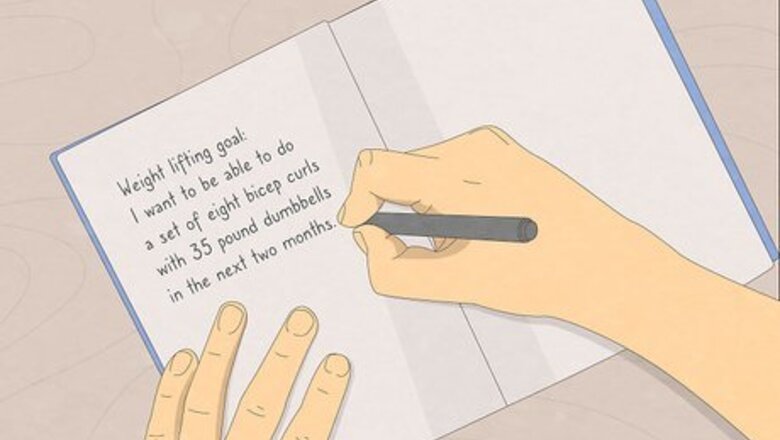
views
Evaluating Your Strength
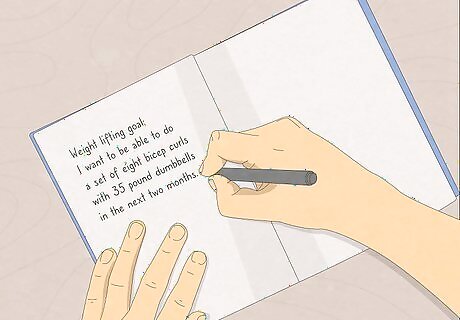
Decide what your weight lifting goals are. Are you trying to develop a single muscle group? Gain stamina? Perform a better curl? Setting your goals will guide your dumbbell selection process. Heavier dumbbells are good for building muscle, while lighter ones are better for stabilizing muscle to support tendons and joints. In general, the larger the muscle group, the more weight it can lift. Use small to medium dumbbells for your biceps, triceps and deltoids, and medium to large weights for working your chest, leg, and back muscles. Write your goals down before and during your dumbbells training. This way, you can stay focused and modify or adjust your intentions if a goal has been met. For instance, you might write, “I want to be able to do a set of eight bicep curls with 35 pound dumbbells in the next two months.”
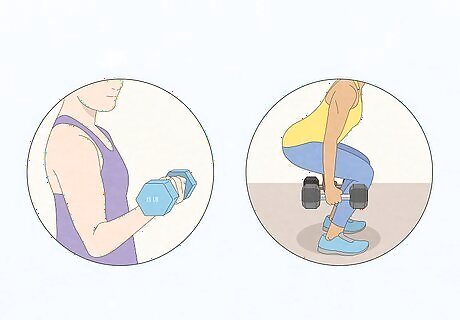
Choose the dumbbell weight corresponding to the exercise and skill level. Depending on the exercise, you might want dumbbells of different weights. For instance, if you’re doing a basic curl, you might be able to curl 15 pounds (6.8 kg). If you’re doing a squat with your dumbbells, however, you might choose a 20 or 25 pound (9 or 11 kg) dumbbell set. Likewise, if you are learning a new exercise, you will want to start light and focus on building proper form before adding weight. Don’t settle for just one set of dumbbells. Ensure you have a range of different weights to accommodate the various exercises you want to perform. Most beginners should have three sets of dumbbells, a light one, a medium one, and a heavy one, to accommodate different types of exercises.
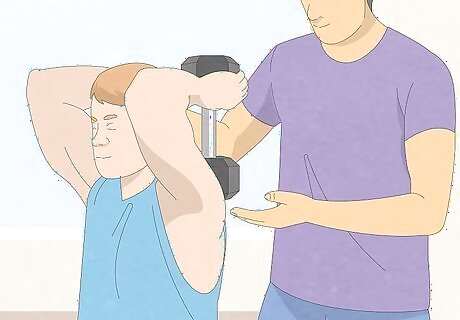
Set up a session with a personal trainer or join a workout program. Get a qualified professional to evaluate your strength and advise you as to which dumbbell weight is right for you. Many gyms and workout programs have such professionals on hand in order to provide you with guidance and show you how to perform certain exercises properly. Don’t be shy -- just let the trainer know directly that you’re new to the world of dumbbells and are interested in their thoughts regarding which would be best for you.
Putting Your New Dumbbells to Use
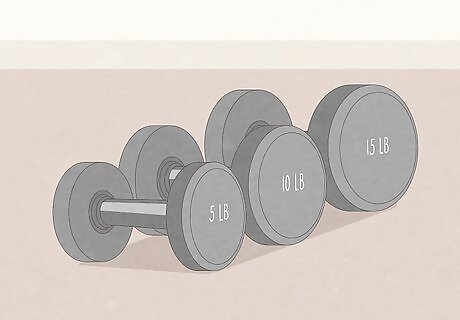
Choose the weight based on your strength level. Start with a low weight, like 5 pounds (2.3 kg), and do a few repetitions of a simple exercise like bicep curls. Increase the weight by 2.5 pounds (1.1 kg) until you get to a weight that is difficult to use for the exercise. Then, go down one increment. This will be the best weight for you to start at. Keep a journal recording how many reps of each exercise you did, the weight you chose for that exercise, and your feelings about whether it was too light, too heavy, or just right. Always choose the weight that’s right for you. Listen to your body to decide what’s right for you. Do not select a weight based on what others of your age or gender are lifting. The only person you should be trying to beat in a dumbbell-lifting competition is you.
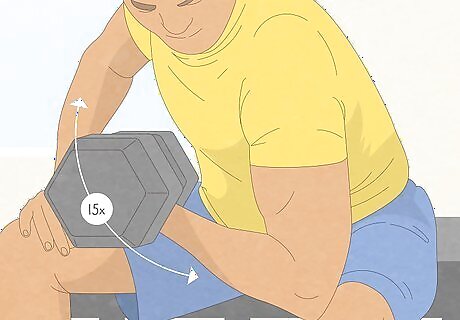
Know when to add weight to your dumbbell workout. Once you have found the right dumbbell weight for an exercise, start to increase one or two pounds at a time to meet the needs of your growing muscles. If you aren’t feeling a moderate to intense muscle strain after performing 15 reps of a given exercise, it’s time to add some weight or procure heavier dumbbells, or otherwise change the exercise. Carefully monitor how many sets and reps you can do continuously and, if you find that you can do more than your target number of repetitions, increase the amount of weight you're lifting by one to two pounds. Incorporating different exercises for the same muscles can change how the muscle is targeted. If you are not feeling strain with one exercise, try another to develop more complete strength. EXPERT TIP Laila Ajani Laila Ajani Fitness Trainer Laila Ajani is a Fitness Trainer and founder of Push Personal Fitness, a personal training organization based in the San Francisco Bay Area. With over 10 years as a trainer and exercise specialist, Laila has expertise in competitive athletics (gymnastics, powerlifting, and tennis), personal training, distance running, and Olympic lifting. Laila is certified by the National Strength & Conditioning Association (NSCA), USA Powerlifting (USAPL), and she is a Corrective Exercise Specialist (CES). Laila Ajani Laila Ajani Fitness Trainer Gradually increasing the weights you lift in the gym will help keep you motivated. For each exercise, start with a weight you can handle for three sets of 4-8 reps, then increase the weight for the next workout while keeping the same routine. People become addicted to strength training because they enjoy tracking their progress and seeing their numbers increase.
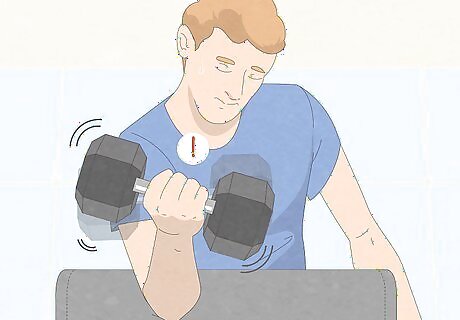
Recognize when you’re trying to lift too much. Normally, this shouldn’t be a problem, since as a smart and safe weightlifter you’ve started out at the low end of your dumbbell weight-lifting range and worked your way up. Never start out with a heavy weight and work your way down to the weight you need to be at. When first starting with a particular weight, if you cannot do more than seven reps of a given exercise, it is too heavy for you. Set the weight which is too heavy aside and select a dumbbell one to three pounds lighter, depending upon what is available. Adjust in small increments to get the best possible weight for your exercise. Picking a weight that is too heavy can cause you to develop bad form and, more seriously, injure yourself.
Exercising with Dumbbells
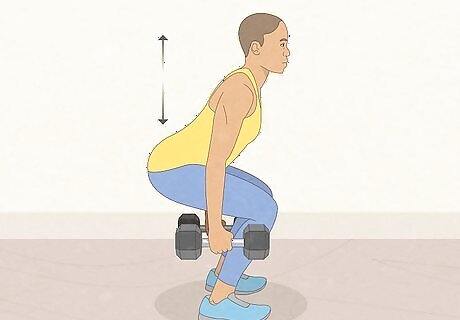
Learn to squat. A dumbbell squat involves holding the dumbbells in your hand at hip or shoulder level. Hold the dumbbell with your palms facing your shoulders or hips. Grip the dumbbells in both hands while leaning back on your heels and lowering yourself down as if you’re sitting. Bend at your knees until they come to a ninety degree angle, then return to a standing position. To keep the knees safe, keep them aligned vertically above the ankle. The knee should never extend past the toes.
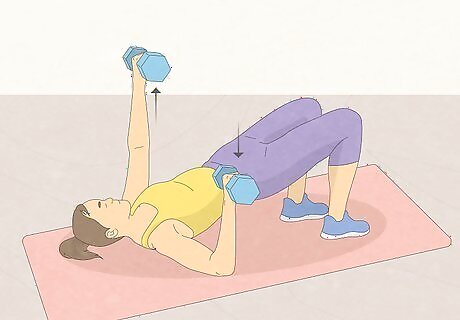
Perform a glute bridge chest press. A chest press can help you build stronger chest muscles. Lie on your back with your feet placed firmly on the floor, knees, bent, and heels tucked in close to your rear end. Lift your rear off the floor. Then, straighten your back and maintain a straight line from your shoulder to your knees. With your dumbbells in hand, put your hands straight out in front of you from the shoulder. Bring one arm down laterally so your elbow makes a ninety-degree angle, but keep your forearm in a vertical position. Your arm should come down and towards you as if you are opening a cabinet door. Re-extend your hand and arm to its starting position and perform the same movement with your opposite arm.
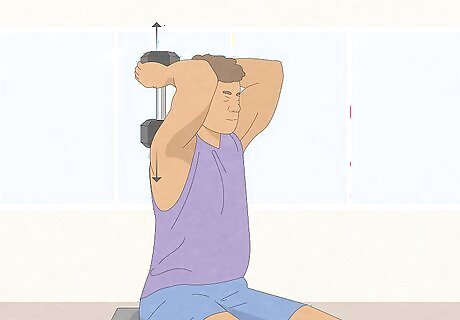
Try a dumbbell tricep extension. Sit on a flat bench or box. Hold your dumbbells a few inches apart in a vertical orientation behind your head. (To accomplish this pose, imagine you had your fingers interlocked behind your head and have just started to unbind them and turn each hand into a fist.) Bending your elbows, lift the dumbbells up and over your head until your arms are fully extended above your head. Keep your back straight and your head facing forward throughout.
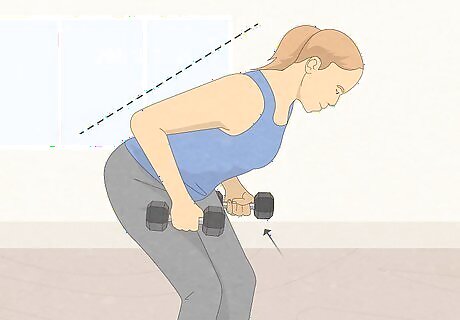
Practice the dumbbell bent over row. Hold the dumbbell in your hands and stand with your feet shoulder-width apart. Bend your knees slightly, then lean forward from your hips, keeping your back straight. Hold your arms straight below your shoulders, and slowly raise them until your elbows line up parallel with your spine. Slowly lower the weights back to your starting position, then repeat for the desired number of reps.




















Comments
0 comment